Have you ever noticed small white spots on your skin? These spots can appear for a variety of reasons, ranging from harmless conditions to ones that require medical attention. White spots are often caused by disruptions in melanin production, the pigment responsible for skin color. Factors like sun damage, fungal infections, or autoimmune diseases may be the underlying cause.
In this guide, we’ll explore the common causes of white spots, their symptoms, and the best prevention and treatment strategies. Whether your concerns are cosmetic or related to your health, understanding the root cause is the first step.
What Causes White Spots on the Skin?
White spots occur when melanocytes, the cells that produce melanin, are damaged or stop functioning properly. These spots can vary in size, shape, and severity. Some are purely cosmetic, while others may signal underlying health conditions.
Common Causes:
- Aging: Loss of melanin as part of the natural aging process.
- Sun Damage: Prolonged UV exposure can kill melanocytes.
- Fungal Infections: Overgrowth of fungi can disrupt skin pigmentation.
- Autoimmune Disorders: The immune system may mistakenly attack pigment cells, as in vitiligo.
- Post-Inflammatory Changes: Injuries or inflammation can leave residual white spots.
Common Conditions and Their Symptoms
Tinea versicolor
y skin, a weakened immune system, hormonal changes, and excessive sweating. This skin condition is commonly found among adolescents and young adults, while it frequently appears in adults when they visit warm and humid climates. When the yeast overgrows, it results in pigment differences on the skin, which can cause both light and dark spots, depending on skin type.
Although tinea versicolor is not contagious, it can cause itching and fine scaling, especially when it is active. Once it is less active, it sometimes leaves white residual spots that are difficult to tan with in the sun. These spots can remain visible for months, which can be cosmetically distracting for patients.
Treatment options: Tinea versicolor is usually treated with antifungals, which are often available as over-the-counter creams or shampoos. These can effectively remove the discoloured spots. If these do not work, it is recommended to consult a doctor for further investigation and a prescription for stronger topical agents or oral antifungal medication.
Although the infection is usually easily treatable, discolouration of the skin may remain visible for weeks to months after the end of treatment. In addition, the condition may recur, especially when exposed to warm or humid environments, or due to hormonal medication. Regular preventive treatment with shampoos or medication can help prevent new outbreaks.
- Symptoms:
- Light or dark spots on the chest, back, or arms.
- Mild itching and fine scaling.
- Who’s at Risk?
- Adolescents and young adults.
- People living in hot, humid climates.
- Treatment:
- Antifungal creams or shampoos (e.g., ketoconazole).
- Oral antifungals for severe cases.
💡 Pro Tip: Use an antifungal shampoo weekly to prevent recurrence.
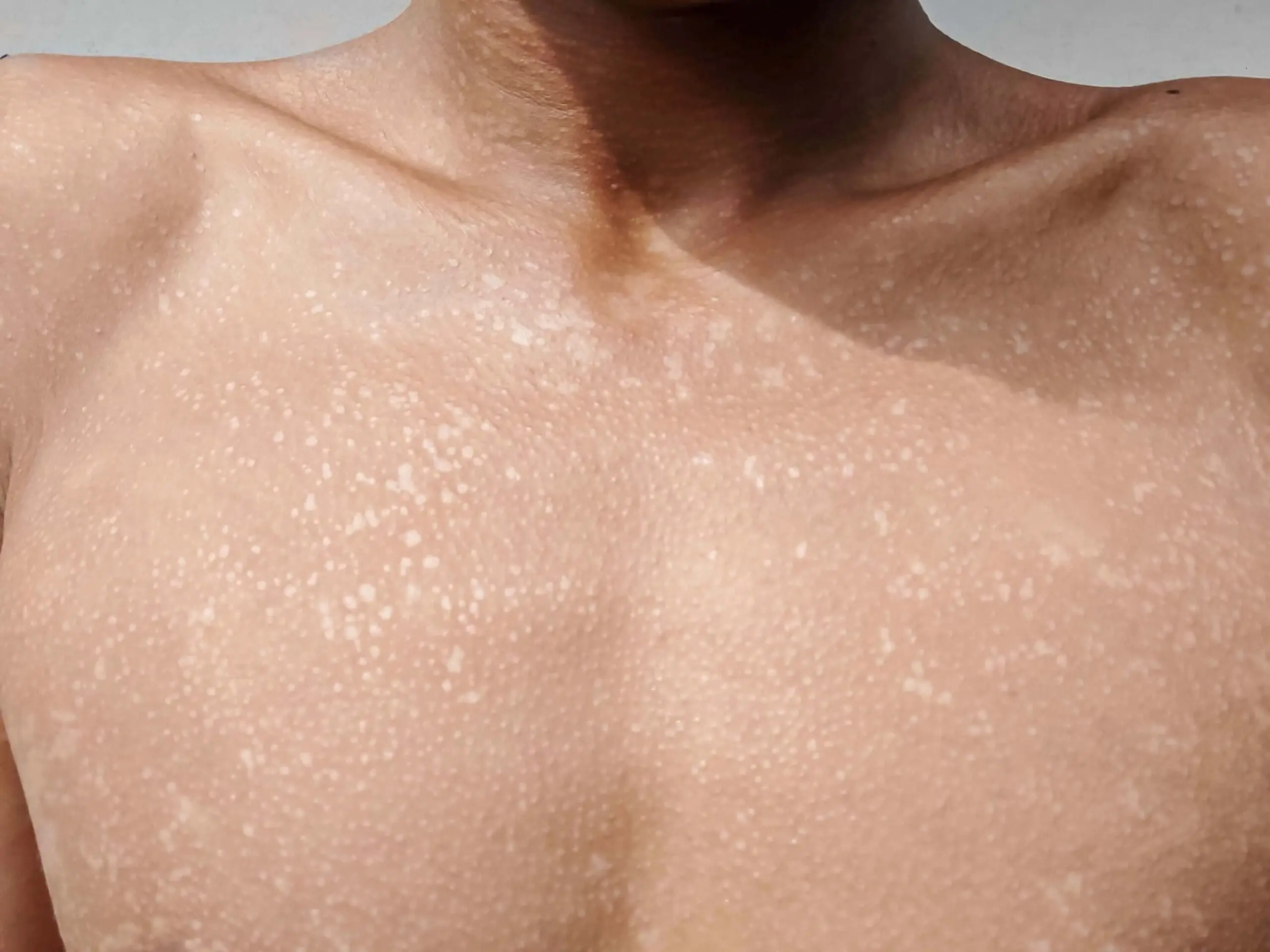
Lichen sclerosus: Chronic but Manageable
Lichen sclerosus is a chronic skin condition that mainly affects the genitals, but can also occur in other areas. The cause is unknown, but sex hormones probably play a role, given its peak onset between puberty and menopause, and it is more common in women. The condition is also often associated with other autoimmune diseases, such as diabetes. It is not contagious and cannot be spread to other people through intercourse.
Symptoms vary from lichen sclerosus. In women, severe symptoms often include white discolouration, itching, pain, and hardening of the vulva, which can also lead to reduced vaginal access. In men, it occurs on the glans and foreskin, which can lead to narrowing of the foreskin. Children, especially girls aged between 4 and 7 years, can also be affected, with skin changes around the genitals and anus. The condition increases the risk of skin cancer in adults, especially if the disorder persists for longer, although the exact risk is not well known. Regular skin checks are important.
Treatment options: Although there is currently no cure for the condition, symptoms can be managed with the use of steroid creams and ointments. When used correctly, the creams usually help ease or alleviate symptoms. In cases of narrowing of the foreskin or urethra, surgery may be required. CO2 laser treatment can also be considered to help reducing symptoms. In children, treatment is often not necessary, as the condition often disappears spontaneously, although symptoms can persist.
- Symptoms:
- White, shiny patches.
- Itching, pain, and thinning skin.
- Treatment:
- Topical steroids to reduce inflammation.
- Surgical options for severe scarring.
💡 Did You Know? Lichen sclerosus increases the risk of skin cancer in untreated cases.
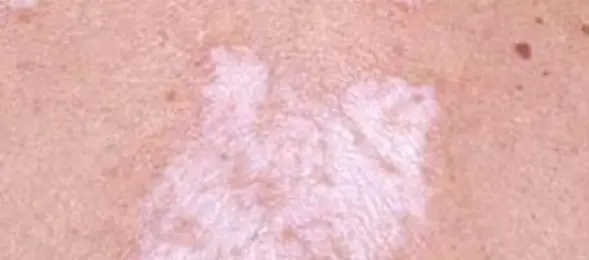
Read more: What does a normal mole look like?
Eczema: More Than Just Itchy
Eczema, also known as atopic dermatitis, is a skin condition that causes red, itchy, and dry skin as a result of inflammation. Sometimes white patches or spots can appear within a red rash.
This condition is typically found in children but can continue into adulthood. Eczema symptoms include dry, scaly, thickened skin that is almost always itchy. Especially among darker-skinned people, eczema can cause skin discoloration, making the affected area lighter or darker than the surrounding skin.
The cause of eczema is unknown, but it is thought to be linked to allergies and asthma and is suspected to be an overactive immune response to an irritant. While there is no cure for the condition, symptoms can be managed. For many people, eczema will even go away over time.
Treatment options: Doctors can prescribe topical corticosteroid creams and ointments, oral medications, and light therapy to help ease symptoms.
- Symptoms:
- Dry, flaky skin with white patches.
- Treatment:
- Topical corticosteroids, moisturizers, and antihistamines.
💡 Pro Tip: Avoid harsh soaps and fragrances to minimize flare-ups.
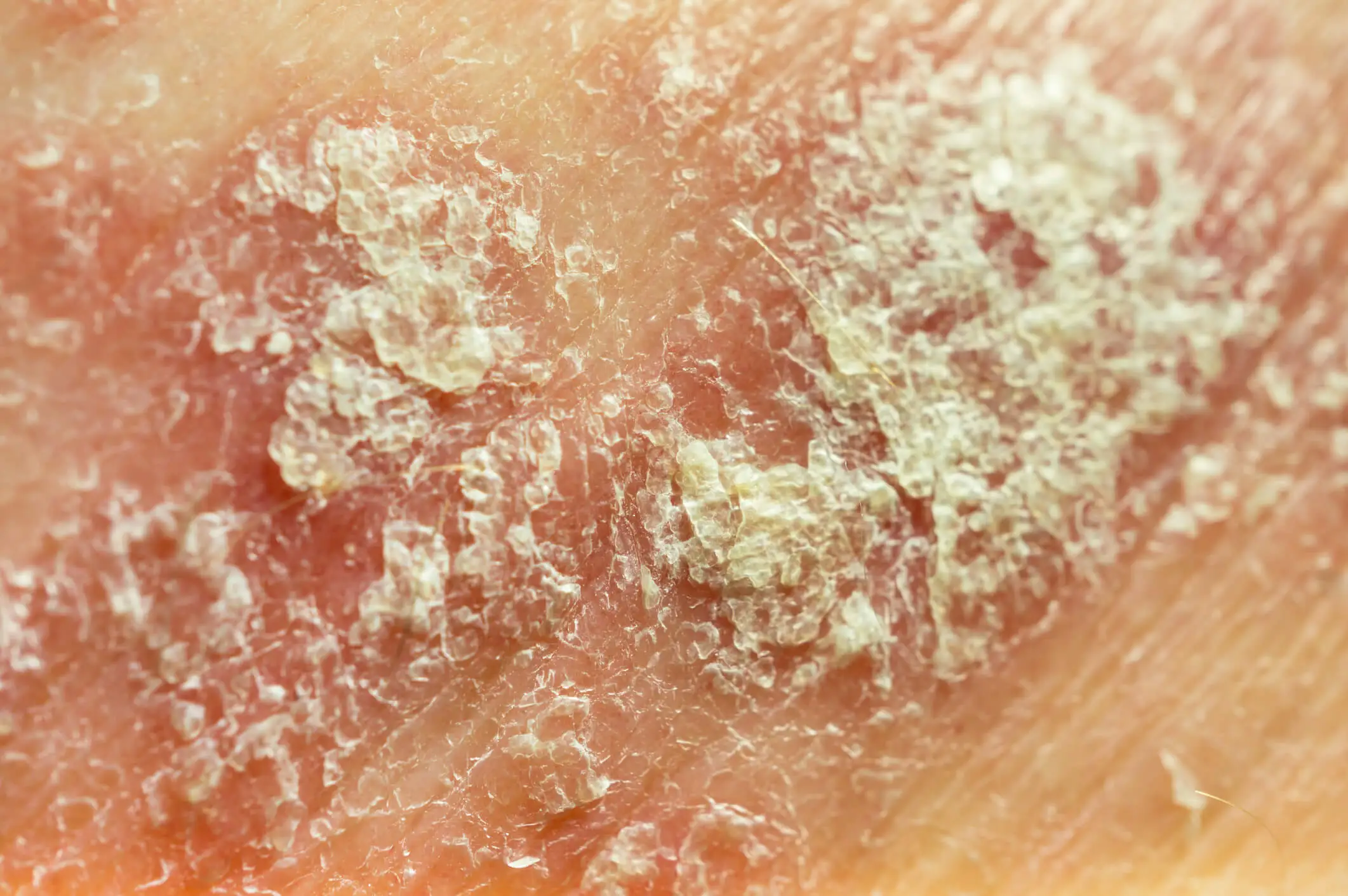
Pityriasis alba
Pityriasis alba is a common, mild, and harmless skin condition that primarily affects children and teenagers. It appears as faint, pale pink or red patches that become lighter than the surrounding skin over time. These patches are more noticeable in individuals with darker skin, especially during summer when surrounding skin darkens due to sun exposure.
The exact cause of pityriasis alba is unknown, but it is considered a mild form of eczema, often related to atopic predispositions such as constitutional eczema, hay fever or asthma. Inflammation of the skin during eczema causes less pigment to be produced, leading to the characteristic white patches.
- Symptoms:
- Faint, lighter-colored patches, sometimes pink or red.
- Mild scaling, dryness, or slight redness.
- Typically found on the face, neck, trunk, or arms.
- Causes:
- The exact cause is unknown, but it is considered a mild form of eczema.
- Often associated with atopic conditions like hay fever, asthma, or constitutional eczema.
- Inflammation reduces melanin production, leading to white patches.
- Treatment Options:
- In most cases, pityriasis alba heals naturally over time.
- Moisturizing creams can reduce dryness and flaking.
- Anti-inflammatory creams or light therapy may be prescribed in severe cases.
- Sunscreen is recommended to protect the skin and reduce contrast between patches and surrounding skin.
💡 Tip: Use sunscreen
Read More: Early melanoma symptoms and how to spot them
Halo Nevus (Mole)
A halo nevus is a mole surrounded by a white border (halo). This white border occurs because the immune system attacks the pigment cells in the mole, resulting in an inflammatory reaction. This can also lead to the disappearance of pigment cells in the surrounding skin.
The exact cause of this reaction is not yet fully understood, but it is common in young people between the ages of 15 and 20 and it may be associated with vitiligo.
- Symptoms:
- A mole with a depigmented ring or halo.
- Often occurs in young individuals aged 15-20.
- Causes:
- The exact cause is unclear, but it may be linked to vitiligo or immune system responses.
- Treatment Options:
- Typically, no treatment is required as halo nevus is benign.
- If the mole appears abnormal, consult a dermatologist for further examination.
- Sunscreen is essential to protect the depigmented halo, which is more susceptible to sunburn.
💡 Did You Know? A halo nevus is often harmless but may sometimes disappear completely as part of the immune response.
Nevus Depigmentosus (Achromic Nevus)
Nevus depigmentosus is a rare, congenital skin condition that typically appears in newborns or children under three years old. It manifests as a hypopigmented patch caused by disrupted melanin production or transport in the skin.
- Symptoms:
- A single, stable patch of lighter-colored skin.
- The spot does not change in shape or size but grows proportionally with the child.
- Commonly found on the trunk, extremities, or neck.
- Causes:
- Unlike vitiligo, melanocytes are present but fail to produce sufficient melanin.
- Treatment Options:
- Nevus depigmentosus is difficult to treat.
- Light therapy may worsen the contrast between the patch and normal skin.
- Excimer lasers or skin grafting have been attempted with mixed results.
- Camouflage creams offer a practical cosmetic solution.
- Sun exposure is not recommended, as the depigmented patch is more prone to burning and increased visibility.
💡 Tip: Consider using cosmetic solutions like camouflage creams to blend the s
Progressive Macular Hypomelanosis (PMH)
PMH causes multiple small, lighter patches on the trunk, particularly on the back and chest, which may increase in number and size over time. The patches don’t cause any symptoms, but some find it cosmetically bothersome.
The exact cause of PMH is unclear. It may be linked to the presence of Propionibacterium acnes bacteria, which live on the skin and hair follicles and contribute to development of acne. These bacteria are believed to produce a substance that reduces the production of pigment by skin cells. The number of pigment cells in the affected areas remains the same as in normal skin.
Treatment:
- UVB light therapy and topical creams.
Leukonychia: White Spots on Nails
White spots on the nails, known as leukonychia, are often caused by trauma or injury to the base of the nail, such as bumping or hitting the finger. It can also be caused by other skin conditions the cause of these spots can also be a result from past infections or illnesses or skin conditions like eczema, psoriasis, or nail fungal infections.
These spots on the nails can appear as small dots (leukonychia punctata), stripes (leukonychia striata), or in rare cases, the entire nail may turn white (leukonychia totalis). The spots typically appear on the fingernails, especially since they are more exposed to injury than toenails. These spots are generally harmless and do not cause symptoms, but they may be cosmetically concerning for some individuals.
- Symptoms:
- Small dots, stripes, or entirely white nails.
- Causes:
- Nail injuries, vitamin deficiencies, or eczema.
- Treatment:
- Spots typically grow out naturally.
- Use nail polish to conceal cosmetic concerns
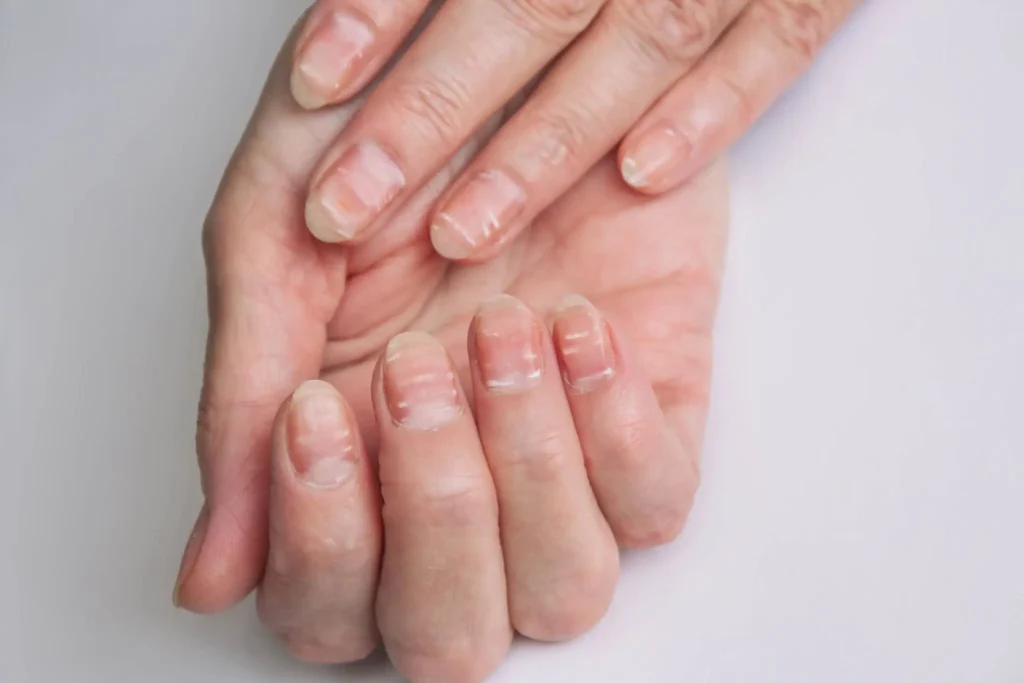
Idiopathic Guttate Hypomelanosis: Aging and Sun Exposure
Idiopathic guttate hypomelanosis is a skin condition in which small, round, white-coloured patches appear, especially on the lower legs, forearms and upper back. These spots, often 2-5 millimetres in size, are sharply defined and completely depigmented. Although harmless, they can be cosmetically disturbing. The skin condition is more common in fair-skinned people and occurs mostly in people over 40 years of age. It is not contagious.
Heredity and sun exposure seem to contribute to the development of this condition. In darker skin, the white spots are more prominent, but the condition is less common. Prolonged exposure to sunlight seems to affect pigment cells in the skin. The spots rarely occur on the face, suggesting a more complex cause.
- Symptoms:
- Smooth white spots, 2-5 mm in size.
- Prevention:
- Apply sunscreen to minimize UV damage.
- Use self-tanners to reduce the contrast.
Vitiligo
Vitiligo is a pigmentary disorder in which the skin and hair lose pigment as the melanocytes in the epidermis disappear or stop functioning. It causes white patches that take different sizes and shapes. Often these spots form around body openings and body folds, causing the skin condition to show up in visible areas. It can appear at any age and on any part of the body. Vitiligo is generally harmless and not contagious, but its aesthetic appearance can cause emotional and psychological distress in people who suffer from it.
The cause of vitiligo is not completely clear, but it is thought that the immune system attacks the melanocytes. Heredity, emotional stress, sunburn, illness and physical injury may play a role. Sometimes, the white patches will spread throughout the body, while other times, they will remain the same size. Vitiligo often appears initially as a small, pale spot on the skin that, over time, will develop into a larger patch.
- Symptoms:
- White patches that grow over time.
- Premature graying of hair in affected areas.
- Treatment Options:
- Topical corticosteroids and UV light therapy.
- Skin grafting for localized cases.
💡 Tip: Emotional support is essential for managing the psychological effects of vitiligo.
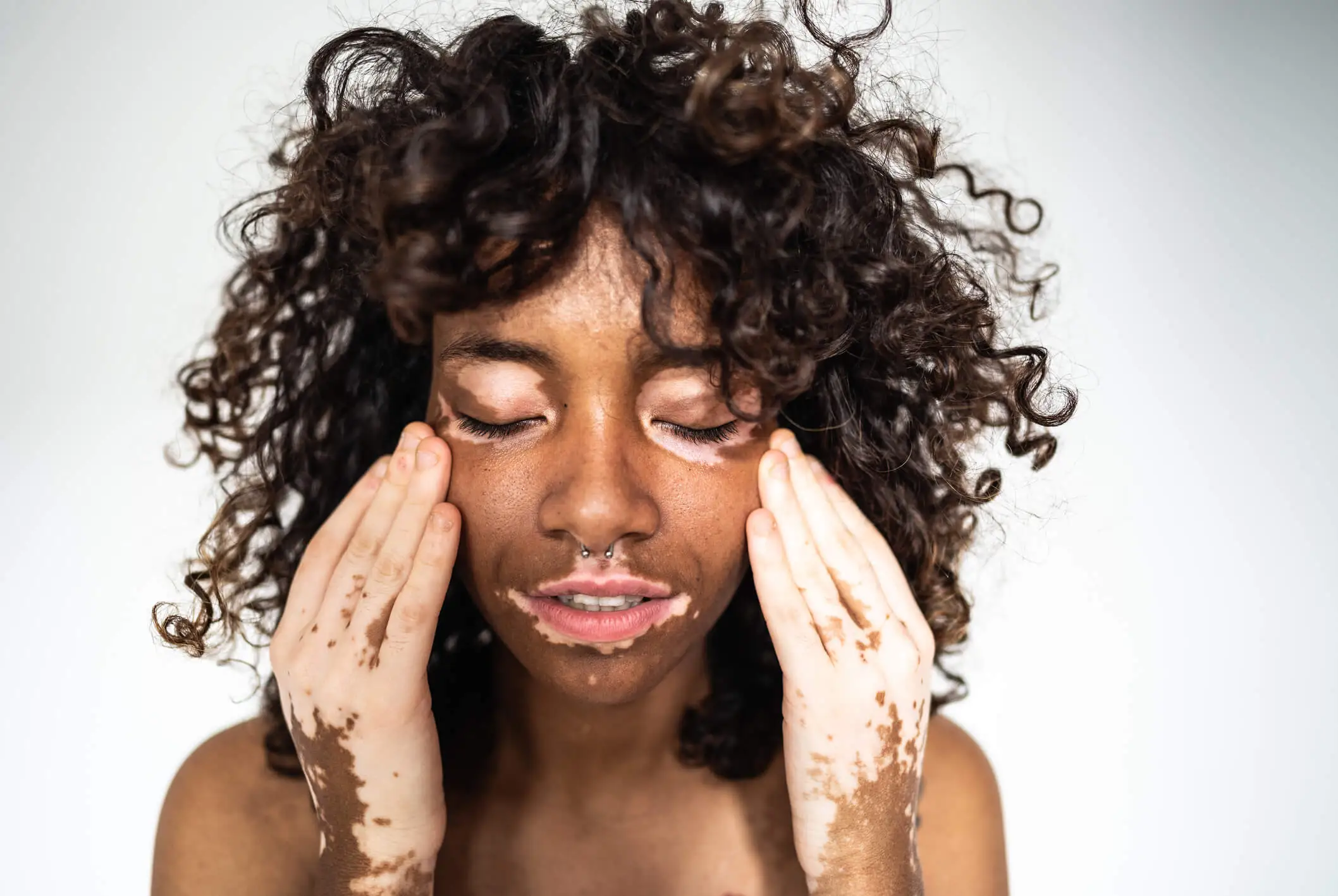
Read more: Skin Pigmentation: What it is and common disorders
White spots from sun damage
While the above skin conditions are mostly through no fault of the sufferer, white spots on the skin caused by sun damage are definitely preventable. In this case, the skin has been so affected by the UV rays that it stops producing melanin – the skin chemical barrier that gives it color.
While these spots are caused by too much sun, they are not skin cancer. However, they can be a good indication that you are spending too much time in the sun and are likely to be a sign that you might have other moles on your skin that you should keep an eye on.
Prevention:
- Wear SPF 30 or higher sunscreen daily.
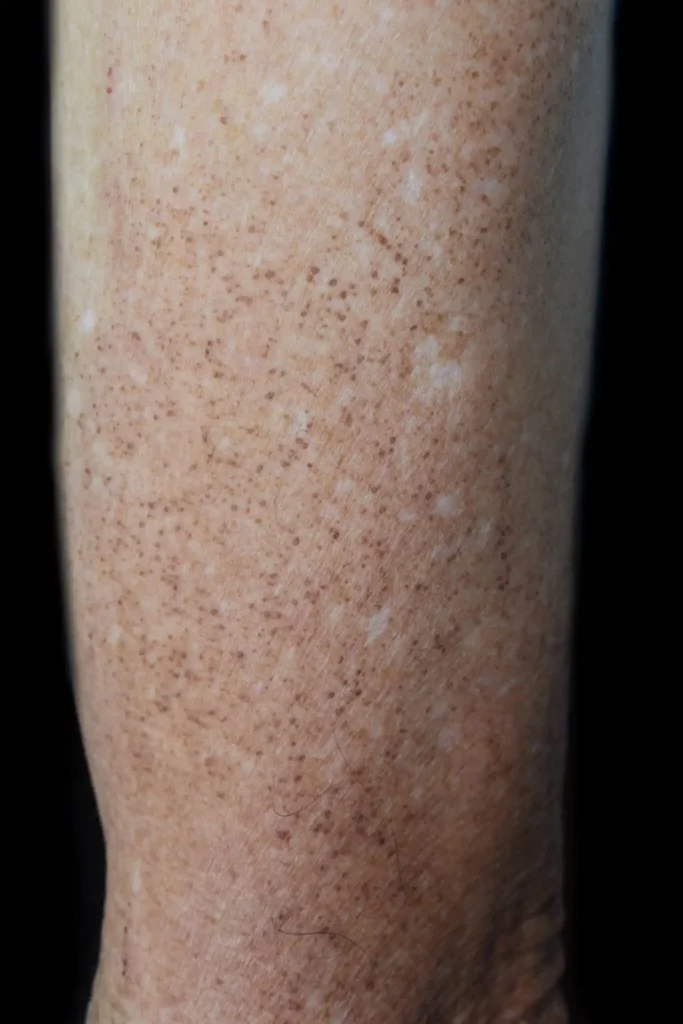
Prevention Tips for White Spots on the Skin
Use Sunscreen: Protect against UV damage.
Maintain Good Hygiene: Prevent fungal infections.
Stay Hydrated: Healthy skin needs moisture.
Monitor Your Skin: Regularly check your skin with SkinVision app for changes.
FAQs About White Spots on the Skin
Q: Are white spots on the skin always dangerous?
A: Not always, but some may require medical attention.
Q: Can white spots be prevented?
A: In some cases, when it’s about sun damage or fungal infections. Genetic white spots can’t be prevented.
Q: What’s the best treatment for vitiligo?
A: To date, no treatment is available that can completely cure vitiligo. However, current forms of therapy can help achieve an acceptable degree of repigmentation (the return of pigment) in most cases and prevent further loss of pigmentation.
Conclusion
White spots on the skin can have many causes, but they’re often manageable with the right care. By understanding their origins and symptoms, you can take steps to treat or prevent them. Always consult a dermatologist for an accurate diagnosis and effective treatment plan.
Take Control of Your Skin Health and Detect Skin Cancer Early!
Worried about white spots on your skin or other irregularities? Early detection is key to preventing serious skin conditions like skin cancer. The SkinVision app empowers you to take charge of your skin health with advanced technology trusted by millions.
- Scan your skin for early signs of skin cancer.
- Get instant risk assessments backed by medical expertise.
- Receive tailored advice to protect and monitor your skin.
📲 Download the SkinVision app now and make early detection part of your routine.
Start You Skin Health Journey
We help you to stay on top of your skin health. Check your skin on your smartphone and get instant results.

















